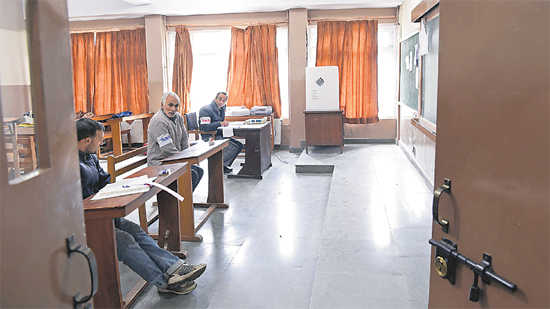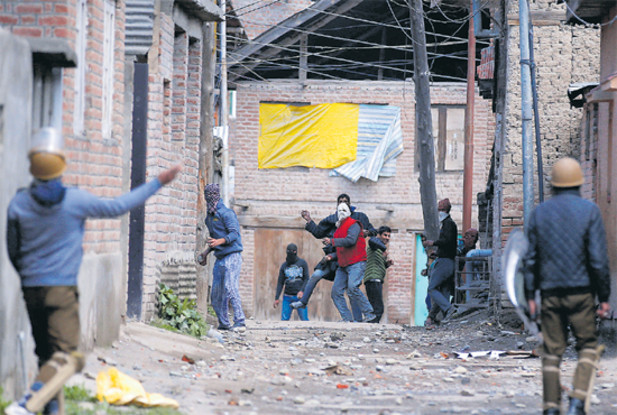We pride ourselves on having a political syetem that is far superior to any in the immediate, even extended, neighbourhoodFrom an impressive 65 per cent in the winter of 2014, the voter turnout plunged to 7 per cent and 2 per cent in the recently conducted Srinagar by-polls. The question that should be worrying us as a nation is: Why and how did the voter turnout crash?

Democracy Disrupted: An empty polling station in Srinagar. Reuters.

IN November-December 2014, the entire nation lauded, indeed celebrated the unprecedented voter turnout in the Jammu and Kashmir Assembly elections. The overall voter turnout of 65 per cent was in freezing temperatures, even as people were struggling to recover from the devastation caused by the terrible floods of September 2014. A little over two years later, the voter turnout in the recently concluded by-polls in Srinagar and Budgam constituencies dipped to 7 and 2 per cent, respectively. We pride ourselves on having a political system that is by far superior to any other in the immediate and extended neighbourhood.Instead of that unprecedented voter turnout, we are now witnessing unprecedented stone-pelting and violence with the rage shamefully engulfing school and college children. The victor and vanquished of the electoral process, and ironically the disruptors of democracy all seem to be together on the same page, as they level accusations and counter-accusations on the violence rather than answering the how and why of the violence.Talking about the Parliamentary elections in April-May 2014, one of the most erudite and experienced personalities of Kashmir had told me, “In Kashmir Farooq Abdullah losing is unthinkable”. He added, the Kashmiri voter had learnt to make choices and more importantly faith in the “Indian” electoral system had been revived.The more critical elections obviously were the Assembly elections, due after some months. He went on to add, “If you succeed in providing that sense of security without being obtrusive or intimidating, people will come out in large numbers.”Soon after our conversation came the unfortunate devastating floods in September 2014. Loss of property was huge, mercifully human loss, though sad was limited, particularly so given the scale of the disaster. Most political quarters made pleas to postpone the elections to the next year, but the people, administration and the security forces were ready to go ahead. The people were desperate to get their flood relief quickly through an effective administration. The Election Commission decided to go ahead in November-December, just before harsh winter sets in. For security forces this is the toughest period when temperatures have dipped but it has not snowed yet.It’s to the credit of all the security agencies the way they came together in true mission mode. They were instructed and convinced of the need to be visible everywhere but not obtrusive. The intensified deployment had to be sustained for nearly three months. An early start was essential for the people to see and gain confidence and equally for the candidates to be able to campaign freely. Joint meetings of all agencies of the core group at the Corps HQ was followed through for the first time with the apex leadership from Srinagar jointly chairing meetings at the district and sub-district level.Unprecedented resource mobilisation from within and outside the Valley was undertaken. For instance, the entire reserve of protected vehicles was inducted from the base depots. Some really innovative technology infusion was done to smarten procedures, particularly in surveillance and interagency communication. Any candidate travelling out would be known to anyone and everyone in the grid who needed to know. Any gathering of people was picked up aerially and monitored closely. The security grid was adapted to meet the changing requirements. There was proper networking and synergy achieved through repeated rehearsals, communication and joint monitoring by leadership of all agencies. Grenades were recovered sometimes just in time and just a whisker away from rally sites.As the election pitch picked up so did the separatists calls for boycott, but the people were in no mood to listen. They wanted a government of their choice that would deliver with urgency — getting the relief before winters was playing uppermost in most minds. The adversary too got panicky by seeing the mood of the people — undergirded by strong security. They made desperate attempts to disrupt by pushing in weapons, land mines and terrorists from across the line of control, all of them were foiled. Highly trained and equipped terrorist groups were eliminated not without loss of blood of the security forces.As the election dates arrived, more security forces came in and polling staff mustered from all over. Absorption and orientation of this added strength was done smoothly of course, with anecdotes of good humour in those stressful circumstances. The polling staff was delivered across remote cross-country terrain in mine-protected vehicles aptly called “Rakshak”. On reaching the destination they would refuse to let go off the hand of the Company Commander. Of course, they understood when reminded that in a democracy the Army cannot be inside a polling booth. The polling staff rose to the occasion. It is to the credit of all the security agencies and the administration that the elections were conducted most professionally. All parties went on record hailing the fairness of the election unambiguously. Not one civilian life was lost in the entire electoral process of the Assembly elections 2014.This was the true victory of democracy, won over all attempts to boycott, disrupt and delay. In many ways, the success removed the very cause for which the militancy began in 1989, that is the alleged rigging of elections. Around the same time as the legislators got voted to power, it was time for the Durbar to move down to Jammu. A royal tradition followed most faithfully even till date where the government moves from Srinagar to Jammu for the entire winter. Incidentally, this winter was just after the floods. Imagine you are voted to power with the hope that you will provide succour and just when you are needed the most you are politicking in fairer weather. This was the beginning of the loss in hopes in leadership and democracy. Ironically, some separatist leaders who claim to be champions of the people’s cause too preferred escape to other areas in the country to avoid the winter cold.The awaam (people), of course, remained in Kashmir and so did the security forces. Avalanches came down, roads got washed away, snow and land slides blocked access, but all these challenges were overcome as the two — awaam and jawan — weathered the harshness of the winter together, waiting for the spring to come, bringing back the political leadership, the Durbar with ominous warnings of a hot summer. This is the story every year!Through the winter of 2014-2015, hectic political parleys led to an “agenda of alliance” — a bridge was supposedly laid between Jammu and Kashmir by Mufti Mohammad Sayeed. Whether it was the fragile health of the well-meaning architect, or was it the fragility of the bridge design or the piers? It was too much for it to withstand the vengeful and vicious designs of the adversaries within and without. For the adversary across and their cahoots, the failed bridge provided ready fodder for vicious propaganda and killing whatever hopes, if any, for democracy.See how effective the vicious propaganda is. So much friction and heat amongst the two; awaam and jawan who weathered the cold winter together.While the victor and the vanquished seem to be obfuscating accountability for the key question, the disruptor of democracy is brazenly manipulating people. This will cost everyone dearly. We should not end up in a situation where democracy is abolished and people’s representation is demolished.The writer was the Corps Commander, Kashmir, in 2014-15.
